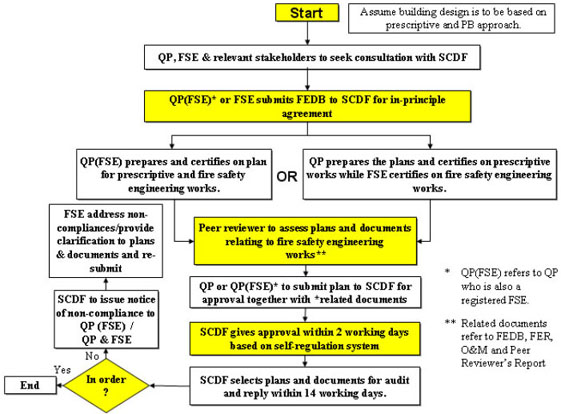The key stakeholders involved in the performance-based plan submission process include:
- Building Owner/Developer/MCST
- Qualified Persons (Architectural/ M&E/ Civil & Structural)
- Fire Safety Engineer
- Peer Reviewer
- Registered Inspector
- Singapore Civil Defence Force
This section outlines the plan submission process involving performance-based solutions, as follows:
1. Engaging Fire Safety Engineer (FSE)
The building owner is required to engage an FSE for the preparation of performance-based solutions as part of the plan submission to SCDF. It is also to be noted that for fire safety engineering design involving structural solution, the owner
needs to engage a FSE who is also a Professional Engineer (PE) in the civil/structural engineering discipline. If the FSE is not a PE(civil/structural), the owner will need to engage a PE (civil/structural) to work together with the FSE.
2. Preparing Fire Safety Engineering Design Brief (FEDB)
The FSE is required to produce a preliminary report - Fire Safety Engineering Design Brief (FEDB) to be submitted to SCDF for in-principle agreement. The FEDB details the proposed fire safety engineering approach, methodology, and software tools
etc. The FSE may consult SCDF on his FEDB proposal prior to its submission.
3. Assessment of FEDB by SCDF
The FEDB will be assessed by SCDF. Click on the link to download the FEDB application form for in-principle agreement. Upon the in-principle agreement of
the FEDB, the FSE can proceed to prepare the following documents:
(i) Revised FEDB*, if conditional agreement is given (ii) Fire Safety Engineering Report (FER)* (iii) Building Operations and Maintenance Manual (O&M)*
In the event that the FEDB is rejected, the FSE will have to go through the process of consultation and re-submission of the FEDB for SCDF's consideration and agreement.
4. Engaging Peer Reviewer
After the preparation of the above documents by the FSE, the owner is required to engage a Peer Reviewer to assess the above documents and ensure that the performance-based solution is incorporated in the Building and M&E plans. The Peer Reviewer
shall produce a report of his assessment in a Peer Reviewer's report.
5. Plans Submission by QP
The Project QP is responsible for collating all the above documents for plans submission to SCDF. Plans containing the performance-based solution shall be endorsed by both the QP and the FSE. QPs who are also qualified FSEs may endorse in the capacity
of both the QP and the FSE. Click on the link to download the application form for Plans Approval FSSD-PA.
6. Audit Checks by SCDF
The submitted plans and documents may be selected by SCDF for subsequent audit checks.
7. Engaging RIs
Upon completion of the fire safety works, the owner is required to engage a Registered Inspector who is an FSE to inspect the performance-based aspects of the fire safety works.
8. Declaration and Endorsement
Click on the link to download the Performance-Based Declaration form for the QP, FSE and Peer Reviewer & the Stamp for FSE plan endorsement.
Note: Under the Fire Safety Act, performance-based solutions are also known as 'alternative solutions'.
The flowchart below illustrates the process for performance-based plan submission:

(a) Fire Safety Engineering Design Brief (FEDB)
Fire Safety Engineering Design Brief is a document summarizing agreed performance criteria and methods that will be used to evaluate trial designs. Generally, the FEDB would define the project scope, stakeholders and design objectives, identify goals, and develop performance criteria, design fire scenarios and trial designs. Upon acceptance of the FEDB by SCDF, the FSE can proceed with the design that best meets the performance criteria.
(b) Fire Safety Engineering Report (FER)
The Fire Safety Engineering Report generally conveys the expected hazards, risks, system performance over the building life, commissioning and maintenance requirements.
The FER should contain appropriate specifications and illustrations of the design. The specifications are derived from the calculations and results within the report, so as to provide the basis for proper execution of the report recommendations.
(c) Building Operations and Maintenance (O&M) Manual
The O&M manual explains what the building operator should do to ensure that the components of the performance-based solution are in place and operating properly. It also gives instructions to the building operator on the restrictions placed on the building, arising from the FSE's assumptions during design and analysis. These may include critical fire load, building use and occupancy, and reliability and maintenance of systems. The O&M manual can be used to communicate to the tenants and occupants about these limitations and their responsibilities. It can also be used as a guide for future renovations and changes to the building.
Click on the link to download the required Format of FEDB, FSER, O&M.
